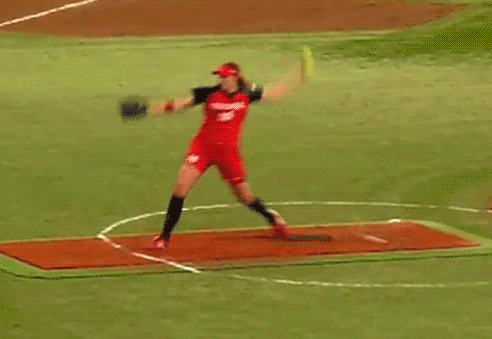Pitching Power: Where Does it Come From?
A few days ago I received this question from reader Kevin:
I have a daughter (15yr) that is a left handed pitcher. She has been challenged by her coach to change the way she is pitching which is to leave her hips more open and to increase her arm speed and pull her trail foot up to the back of her landing foot. He is stating this change is to increase her power. However, her pitching coach is saying this is not correct and that she has fast hips and needs to use them and close to maintain her power.
I have always been told legs and hips vs. arm speed is where power comes from. What is your thought about proper power/mechanics?
There are a number of pitching styles out there and I’m sure their coaches will argue their benefits all day. However, there is a CORRECT ANSWER to this question based on the laws of physics. We’ve discussed where power comes from in many different articles and videos, but let’s collect it all in one convenient place!
Getting the power
The potential max power you can have in your pitch comes from a specific place: the push off the rubber.
Mini physics class:
- Newton’s third law of motion: every action has an equal and opposite reaction. If you push into something, it pushes into you. If you’re bigger and stronger than the thing you’re pushing, your force is going to “win” and you’re going to repel it forward. The harder you push the thing, the farther and faster it will go.
- When you’re pitching, the two objects interacting are you and the earth. In this case, the earth is much bigger and stronger than you, so you are propelled forward. The harder you push, i.e. the more force you put down into the earth, the harder the earth is going to push you back (equal reaction)… meaning, the earth is literally going to put more force into your body. This is called ground reaction force.
- For more detailed info on ground reaction force as it relates to pitching velocity, read this. I highly recommend it.
This is the answer to the question where does power come from. You want more power, you gotta push harder.
However, once you’ve pushed as hard as humanly possible, some other things need to go right.
Getting the power from your push leg to the ball
Once you’ve got that power in your body, you have to make sure it gets transferred to the ball as directly as possible. How does this happen?
- Stride foot hits the ground, stride leg is very strong and basically freezes, creating front side resistance. Learn more about front side resistance here and here.
- THIS along with the push-off is where the power of the legs—which is extremely important—comes into play. YES, the legs are responsible for generating the vast majority of the power in a pitch. NO, it’s not the rotational “closing” or “slamming” of the hips that generates this power. By the time you would get to that part, most of the important power stuff should have already taken place.
- As front side resistance is created, decelerating the front half of the body, the ground reaction force from part 1 is redirected backward toward the pitching arm. Look at this ball bouncing in slow motion. When it hits the ground, it slows down, stops, and reverses direction. The human body is more complex than a ball, but the principal is the same; your landing foot provides the “hitting the ground” action, which allows the energy to reverse direction (in this case, into your softball).
- In order for this to happen as efficiently as possible, the force needs a relatively straight clear path. This is our recommended landing position:

- You can draw a nice straight line from the landing foot to the ball. Nothing is pulling away from that line; the glove is directly over it and the drive leg is directly under it. The hips are also on that line, and they are open to the side (about 45 degrees). They need to remain this way until the ball is delivered, or they will block the pitching arm’s clear path to the catcher.
Keeping as much of the power as possible
In addition to pushing hard and then harnessing that energy with your excellent front side resistance, you need to avoid these things that cause energy to be lost:
- Stiff arm. If your arm doesn’t whip loosely, all of that energy you worked so hard to get will be decelerated and lost when it hits your arm.
- Poor posture. Look at the image above again, and imagine that nice smooth line from the landing foot to the ball. If there is bending in the waist or back, that line becomes more of a zigzag. This is a slower and less efficient path for the force to take.
- Poor drive through. That drive leg needs to power up to the landing leg fast and relatively straight. If it stays back there, it becomes an anchor that decelerates your whole motion. If it deviates from the power line, it pulls some of the energy away from the ball before it can travel all the way there.
- A glove off the power line will also pull some energy away from the ball.